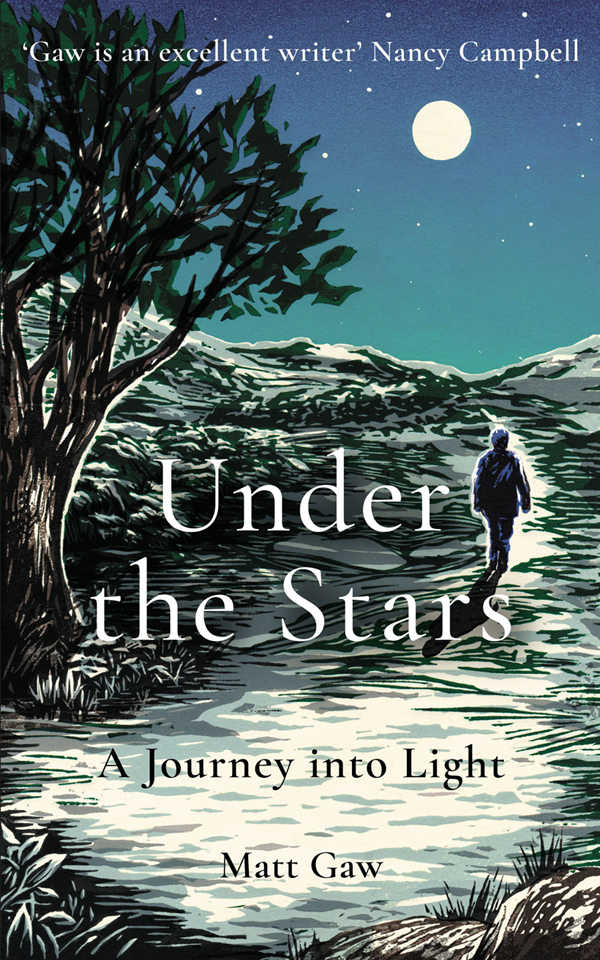Sue Brooks reviews Matt Gaw’s latest, Under the Stars – a call to embrace the natural darkness of the night.

In his first book, Matt Gaw set off to explore the waterways of the UK in a canoe (The Pull of the River: A Journey into the Wild and Watery Heart of Britain, 2018). The second is another exploration, equally elemental and arguably more ambitious. He wants to know more about living in the dark.
He realises it is totally unknown territory – to set out alone at night without torch or wristwatch, to navigate by the stars through the Wood of Cree in Galloway. The previous day was spent at the Dark Sky Observatory, scanning the constellations through the powerful telescope, and he is keen to test out how much he has learned. But the sky has changed. Clouds cover the stars and darkness descends rapidly.
It is terrifying. Without moon or stars his mind goes into overdrive: panic rises and he finds himself sobbing uncontrollably. He is lost, so soon in his quest, and feeling pathetic. It changes again. The clouds drift, break and reform and three hours later he is back at the car, lying on the bonnet enraptured by the Milky Way in all its glory and a glittering Perseid shower.
There are more such encounters. He deliberately seeks out the raw edges of darkness. Wistman’s Wood on Dartmoor, for example; notorious as Conan Doyle’s inspiration for The Hound of the Baskervilles. In preparation for a night walk, he reads the folk tales of the area and decides to follow the Lych Way – the Way of the Dead. Once more the clouds close in and he becomes lost, but calmer than before. Fearful rather than terrified. The darkness is beginning to fascinate and enthral. His perceptions are changing, his senses more acute, his imagination enlarged.
He spends a night in London with a friend walking the streets, appalled by the intensity of artificial light. ‘The darkness seems to live only in the cracks in the pavement.’ It is seen as a crime risk and a safety hazard. ‘We have grown too used to electricity’, he writes, ‘too desensitised to its brightness, unaware of the biological and cultural costs.’ Not only human costs, as he soon discovers, but also profound costs for the natural world.
When he turns his attention towards his home patch in Bury St Edmunds, the effects of the night walks in Galloway, Dartmoor and London become more apparant. He is seeing the familiar territory differently. He reads the 2013 publication Ecological Consequences of Artificial Night Lighting, and understands for the first time the impact modern nightscapes can have on animals and plants. How bright roads and glaring street lights can disrupt and confuse or prevent navigation altogether. In this chapter more than any other, the author, a conservationist with Suffolk Wildlife Trust, begins to protest. ‘Things can change’ he says. ‘They must…..to make sure that the blight of artificial light does not continue to spread.’
The story ends where it began – in Scotland. Not in an Observatory, but on a whole island that has dedicated itself to the darkness. Matt spends a few days and nights on the Isle of Col which was designated a Dark Sky Community in 2013. He is in heaven. He sleeps under the Milky Way once more and wishes on another shooting star. He feels utterly at peace – ‘a strange glassy sensation’ – and understands, looking back on the journey, how he has been able to face up to the darkness and embrace it. To see darkness in a different light.
Nightwalking. It sounds so simple, so achievable. Having read Matt’s account of the infinite riches banished behind our addiction to artificial light, I too want to know more. What does it feel like to be pulled by the stars? ‘Don’t resist,’ he tells me, ‘don’t fight it, feel the motion.’ So – perhaps not alone, and perhaps I will wear my watch and take a torch, but the invitation is irresistible.
*
Under the Stars: A Journey Into Light is out now, published by Elliott & Thompson, and is available here, priced £12.99.
You can read an extract from the Isle of Coll chapter here.